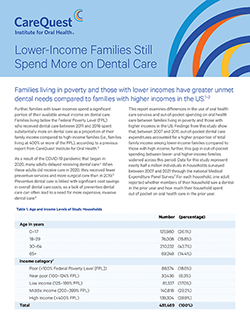CareQuest Institute’s latest analysis of dental care spending and income reveals that inequities in out-of-pocket expenditures between the poorest and wealthiest families in the US have continued to grow. In 2021, the most recent data available, poorer families paid 7.4 times more in out-of-pocket expenditures for dental care compared to high-income families.
Additional Key Findings
- In 2007, the poorest families paid 5.5 times more than the wealthiest families in out-of-pocket expenditures for dental care. By 2021, the poorest families paid 7.4 times more for dental care.
- The percentage of individuals with at least one dental visit within the prior year was substantially lower among poorer households (~25%) than wealthier ones (~55%).
- When people from lower-income families can receive dental care, their households bear a disproportionate burden of out-of-pocket dental costs.
- Comprehensive Medicaid adult dental benefits in all states, increased dental provider participation in Medicaid, and support for safety-net providers serving low-income patients are just a few solutions that would make dental coverage and care more accessible and affordable for low-income families.
You may also be interested in:
- Uninsured and in Need, a visual report, part of our State of Oral Health Equity in America series, estimates more than 68 million US adults do not have dental insurance.
- Medicaid Adult Dental Coverage Checker, an interactive tool for policymakers, administrators, and advocates to easily understand where a given state’s Medicaid adult dental benefits package falls on a continuum from no dental benefits to extensive benefits.
- An Estimated 12 Million Children and Adults Lost Medicaid Dental Insurance, a report that analyzes the impact on dental insurance coverage following the expiration of the COVID-19 public health emergency in 2023.
